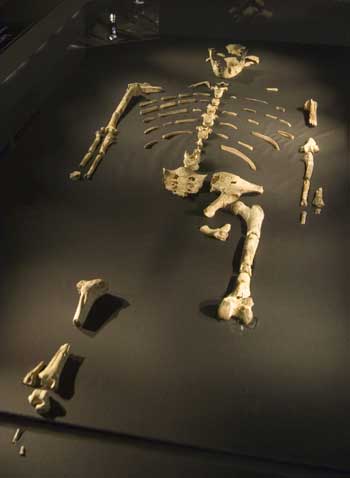
Skeleton fossils of Lucy
THE HIDDEN TREASURES OF ETHIOPIA AND THE WORLD FAMOUS LUCY FOSSIL
AN EXHIBITION OF MONUMENTAL DIMENSION
NOT TO BE MISSED
 |
|
Skeleton fossils of Lucy |
“Lucy’s Legacy: The Hidden Treasures of Ethiopia”, an amazing “not to be missed” International exhibit that traces the history of Ethiopia and mankind through the ages, has opened in a new state-of-the-art exhibition facility located in the former printing presses building of The New York Times at 226 West 44th Street, in the heart of Times Square. One enters a world that is fascinating, informative and thought provoking.
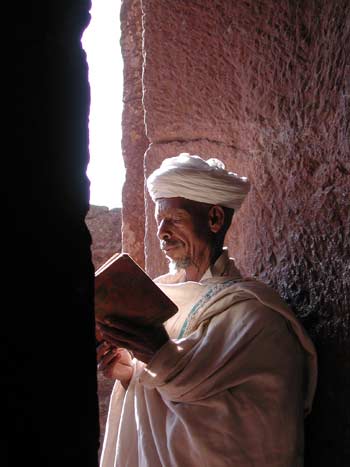 |
|
Lalibela, in the northern highlands of Ethiopia, is famous for its rock-hewn churches. A priest is seen reading a manuscript written in the ancient language of Ge’ez. Image courtesy of the Houston Museum of Natural Science |
Lucy’s Legacy:The Hidden Treasures of Ethiopia was organized by The Houston Museum of Natural Science in collaboration with the Ministry of Culture and Tourism of the Federal Democratic Republic of Ethiopia and the Ethiopian Exhibition Coordinating Committee. It is nationally underwritten by The Smith Foundation and Ethiopian Airlines.
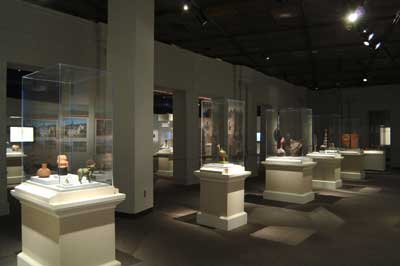 |
|
Artifacts in glass cases |
First mounted at the Houston Museum of Natural History from 2007-2008, the exhibition attracted 210,000 visitors. Dr Dirk Van Tuerenhout, the museum’s curator of anthropology, has mounted a brilliantly creative display that captures the very essence and spirit of a proud nation intent on showcasing its past, as it moves forward to reach its goals for the future.
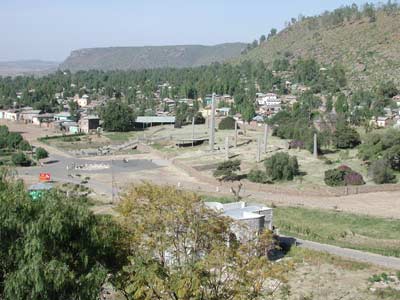 |
|
View of the northern stelae field, Aksum, Ethiopia. This image pre-dates the return of the stela, or obelisk, from Italy. Image courtesy of the Houston Museum of Natural Science |
The exhibit, dating back 7 million years, is fascinating and highly informative. Upon entering the exhibition space, a short film highlights Ethiopia’s rich cultural history that has earned the country 8 World Heritage designated Sites. You will roam through climate changes that affected plants, animals and human life as we know it today. Highlights include: aspects of human evolution as it occurred in Africa, and the fossils that record who we are, and where we came from. It contradicts many theories, provokes many questions, and evokes many profound answers. This is a journey of wonderment and discovery.
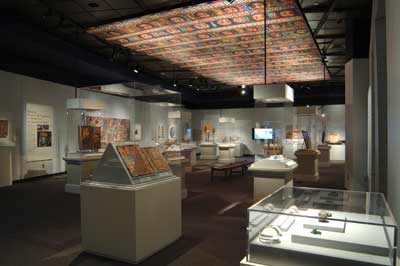 |
|
Overview of the exhibit |
Ethiopia, a land of Kings and a country of discoveries, is the oldest independent nation in Africa; its rich cultural Heritage is one of the world’s best-kept secrets; its recorded histories of humanity and abundance of archeological finds date back to the 4th Century B.C. Ancient Greek historians have referred to them as “a sacred people who were most beloved by the Gods”. Over many centuries, traders from the great civilizations of Rome, Greece, Persia and Egypt discovered its ancient wonders and beauty.
 |
|
Skeleton fossils of Lucy |
“ Lucy’s Legacy” introduces you to the incredible five million-year history of a country, known as “ the Cradle of Mankind”. It is divided into two sections.
PART ONE: Begins with the story of ancient Ethiopia and the Kingdom of Aksum in the northern highlands, established as the first government seat. During the 6th and 7th Century B.C. the city of Aksum, was the center of one of the world’s richest and major old world civilizations of early antiquity. According to tradition, King Menelik, the son of King Solomon and the Queen of Sheba, became the founder of the Solomonic dynasty. The religious biblical story of King Solomon and the Queen of Sheba is both romantic and poignant; had she not returned to Ethiopia, but had remained in Jerusalem, history would have been written very differently. It was their son Menelik who brought the sacred Ark from Jerusalem to Ethiopia. It has been safe guarded in a series of chapels in between civil wars; today it is hidden from the public and can only be viewed by the monk who safeguards the chapel where it remains permanently secured.
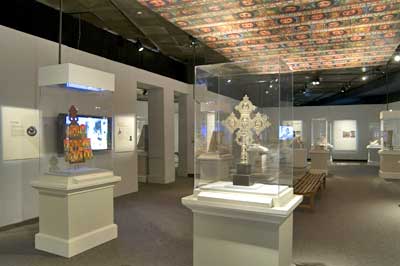 |
|
Glass cases hold priceless artifacts |
In the beginning of the 11th Century, the kingdom’s government seat was moved to the city of Lalibela; then in 1632 it was moved to Gonder. Today, Aksum is the holy city for Orthodox Christianity.
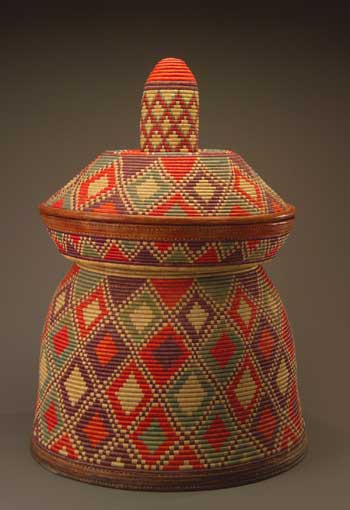 |
|
Ethiopia’s finest basketry, including this example, is produced in the primarily Muslim Harar region. Photo by Thomas R. DuBrock |
During a period of roughly seven centuries, a succession of kings ruled a
territory that covered large portions of present-day
Ethiopia, as well as neighboring
Eritrea and portions of
Yemen. This section follows the country’s
rise in religious, economic and cultural power through the centuries, and ends
with modern Ethiopia, and the end of the
reign of
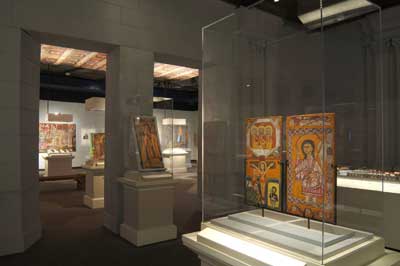 |
|
Ethiopian artists have developed a unique and vibrant artistic style, as showcased in this diptych from the reign of King Menelik. Photo by Thomas R. DuBrock |
The exhibit, presented in videos, wall panels and in free standing glass cases, is also a journey into the development of art; it traces the different kinds of art, and the history of art in the church. More than 100 artifacts, including: fossils, religious items, a life size stone memorial figure placed on the grave of the dead, historical manuscripts, pens, brushes and pumice stones used to write books (over the centuries millions of books were hand written), paintings, the first coins minted by an indigenous African civilization, musical instruments, (including the bagana, a large wooden harp like instrument used for church songs), early stone implements of daily use, hand crafted jewelry, and woven baskets. A 6th – Century BC incense burner is inscribed in Sabaean, a language that evolved into the still spoken Gelez language; nine bronze, gold, metal, wood and silver handheld, processional and benediction crosses engraved in detail depict the history and beliefs of the people who owned them; a selection of Korans from the holy city of Harar (the fourth most important site in Islam), sit on wooden stands. A 20th century wood carved icon depicting the last supper catches my eye; I pause in front of a scale model of the famous Church of St. George in Lalibela.
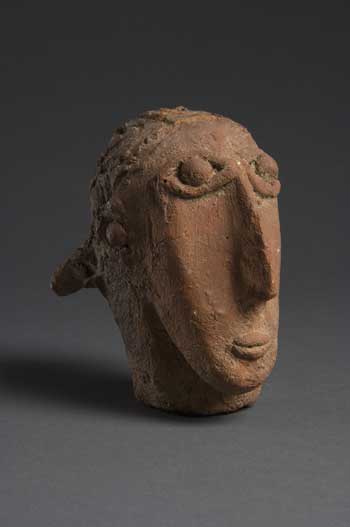 |
|
This ceramic head is from the Beta Israel (literally, “House of Israel”) culture of Ethiopia, comprised of Jews of Ethiopian descent that have had a presence in Ethiopia since the 14th century. Though primarily agricultural, they are also known for their exquisite crafts and jewelry as well as blacksmithing and pottery-making. Photo by Thomas R. DuBrock |
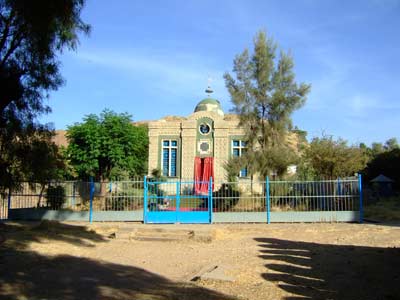 |
|
Chapel of the Ark of the Covenant, Aksum, Ethiopia. This chapel, built during the reign of Emperor Haile Selassie, is the last of a series of chapels dedicated to safeguard the Ark. Image courtesy of the Houston Museum of Natural Science |
Emphasis on geographic and chronological context tells the story of our ancestors. A wide variety of multi-media presentations and text panels also elaborates on what anthropologists do, and how we get from finding a fossil to telling a story such as the one presented in this exhibit.
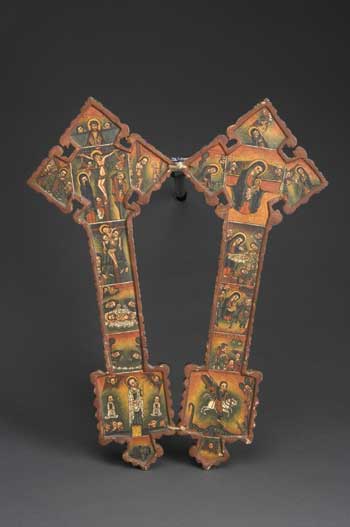 |
|
Two crosses as one |
You will explore aspects of human evolution as it occurred in Africa, and the fossils that record our development, culminating with the display of the world’s most famous fossil, LUCY, whose fame began on November 24, 1974, when Donald Johnson, an archeology professor from Arizona State University, discovered a partial skeleton in the Awash Valley of Ethiopia’s Afar Depression. This famous archeological discovery was the skeleton of a hominid estimated to be a 20 year old female that lived 3.5 million years ago. While her scientific name is Al-288-1, Ethiopians named her “ Dinkenesh” which means “you are beautiful”, but she is most well known as “ Lucy” after the Beatles song “ Lucy in the Sky with Diamonds", popular at the time of the discovery.
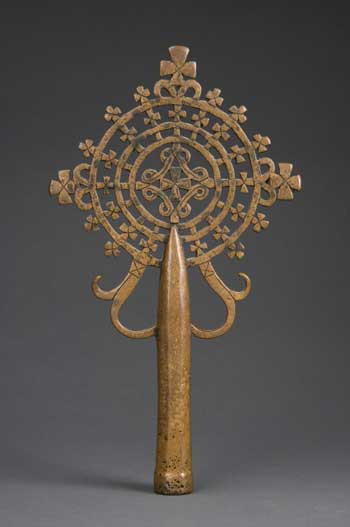 |
|
Cross |
The original fossils of Lucy are in a hermetically sealed case; another case of reproductions were used to determine how she looked, in order to show how the past connects to the future; there is a highly mesmerizing video that shows how she was replicated and reconstructed.
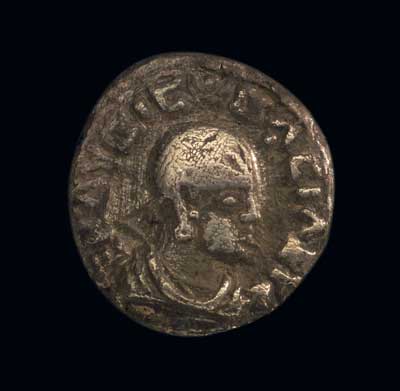 |
|
The Ethiopian civilization of20Aksum produced the first indigenous coinage in Africa. This example is from the reign of King Endubis, the very first African king to mint coins. Photo by Thomas R. DuBrock |
Curator Dirk Van Tuerenhout, attending the New York opening, tells me: “Recent scientific research conducted on Lucy illustrates that she still has stories to tell, Even though she lived more than 3 million years ago, Lucy continues to give us clues about what it means to be a human”. With 40 percent of her skeleton intact, Lucy remains the oldest and most complete adult human ancestor retrieved from African soil.
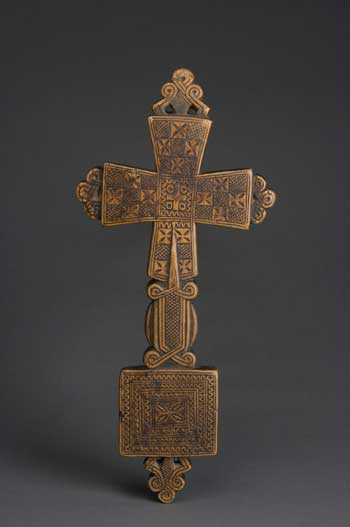 |
|
This 15th century cross has lobes filled with crosses surrounding a central Maltese cross. When in use in religious processions, colorful banners would be draped through the loops on the bottom. Photo by Thomas R. DuBrock |
Visitors not only have the opportunity to come face-to-face with Lucy, but also meet with the earliest known members of our own species, Homo sapiens, who lived almost 200,000 years ago in what is now Ethiopia. Other important paleoanthropological discoveries, also represented complete the current account of human evolution, as known to scientists today.
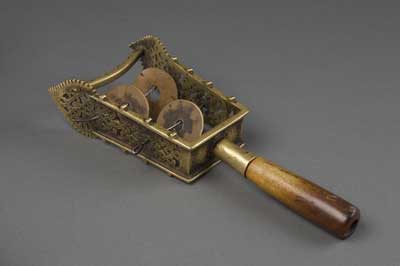 |
|
This musical instrument, consisting of a U-shaped metal frame and metal rings on moveable cross bars, has a history extending back to ancient Egypt. It is still used in the Egyptian Coptic Church and the Ethiopian Orthodox Church. Photo by Thomas R. DuBrock |
Ethiopia’s Future:
Ethiopia with more than 80 ethnic groups, each with their own language, is a model of tolerance and co-existence between these diverse groups. With strong, Judaic, Christianity and Islam religious ties; the legend of Queen Sheba and King Solomon continues to influences Ethiopian traditions.
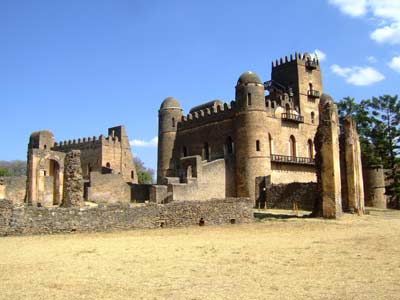 |
|
Gondar, located north of Lake Tana in northern Ethiopia, is known for its castles. These structures served as palaces for Ethiopian emperors during the 17th and 18th centuries. Image courtesy of the Houston Museum of Natural Science |
The future of Ethiopia is very promising. Ethiopia, the only country in Africa that has never been a colony of another state, remains independent in its thinking, but conscious of its need for dependence on the world in order to evolve into a democratic nation.
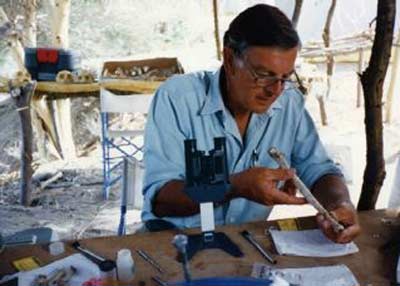 |
|
Dr. Donald Johanson, discoverer of Lucy, doing research in the field. Photograph courtesy of Dr. Johanson |
According to my host for the tour, Reta Alemu Nega, Minister Counselor for the Permanent Mission of Ethiopia,: “We are 77,000,000 people on the right path to development … our goal is to alleviate poverty, improve our health care and raise our levels of education. In the past 10 years, the number of universities has increased from 3 to 31. My government is doing its best to develop our economy . . . and increase investments, exports and tourism”.
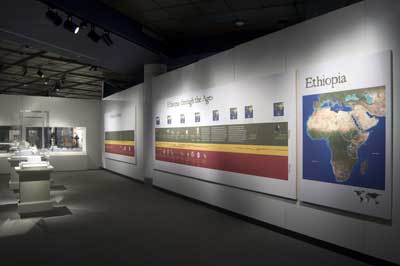 |
|
Ethiopia through the ages |
The Hidden Treasures of Ethiopia Exhibition, with its wealth of fascinating and engaging artifacts, is enriching New York’s dynamic and unsurpassed cultural landscape. It is also an impressive “ Ambassador of Good Will”, and an integral part of an African nation’s efforts to build a democratic system and enhance their image throughout the world.
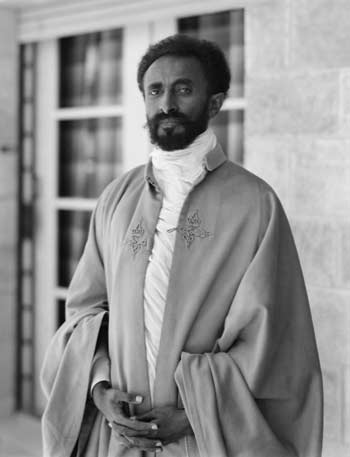 |
|
Emperor Haile Selassie, last Emperor of Ethiopia |
“Over the past decade, wondrous exhibitions traveling the United States have bypassed New York time and again simply because no venue existed to host them,” said James Sanna, President and Executive Producer of Running Subway Productions. Discovery Times Square Exposition Center creates a new world-class home in New York for great exhibitions with the debut of its first exhibition.
 |
|
Mural wall of apes |
This NOT TO BE MISSED treasure, on display through Oct. 25, 2009 at Discovery Times Square, 226 West 44th Street, will change your life . . . and how you perceive life. Lucy’s Story is my story . . . and your story. The mysteries of mankind, revealed and unraveled in this compelling journey back in time, will leave you pondering the controversial question “are we are all descendants of Lucy”?
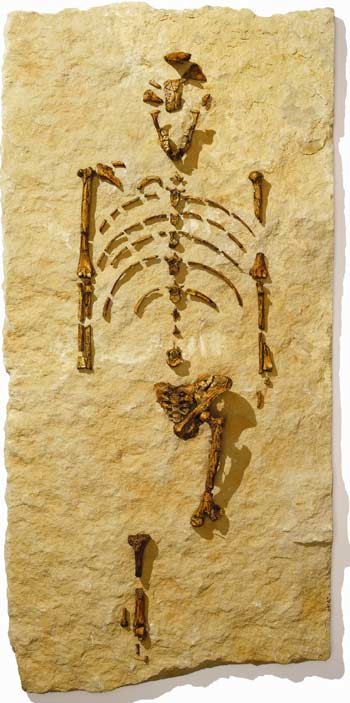 |
|
A replica of Lucy’s skeleton. When Lucy was discovered in 1974, she was the oldest and most complete human ancestor known. Image courtesy of the Houston Museum of Natural Science |
The Legacy of Lucy Exhibition will travel to other cities at the conclusion of its New York showing.
Tickets for “ The Legacy of Lucy Exhibit” can be purchased at the box office, or from: www.ticketmaster.com
For more on Ethiopia: www.seeethiopia.com
Ethiopian Airlines, the flagship carrier, has over the past 60 years, become one of the continent’s leading carriers, serving 53 International destinations. Ethiopian Airlines Journeys has just launched a brand new exciting “ Lucy’s Legacy Tour”, to celebrate the world’s most celebrated ancestor, with non-stop service from Washington, D.C. and connecting flights throughout the USA.
 |
|
Ethiopian Airlines |
For more info on Ethiopian Airlines and the “ Legacy of Lucy Tour”: http://www.ethiopianairlines.com